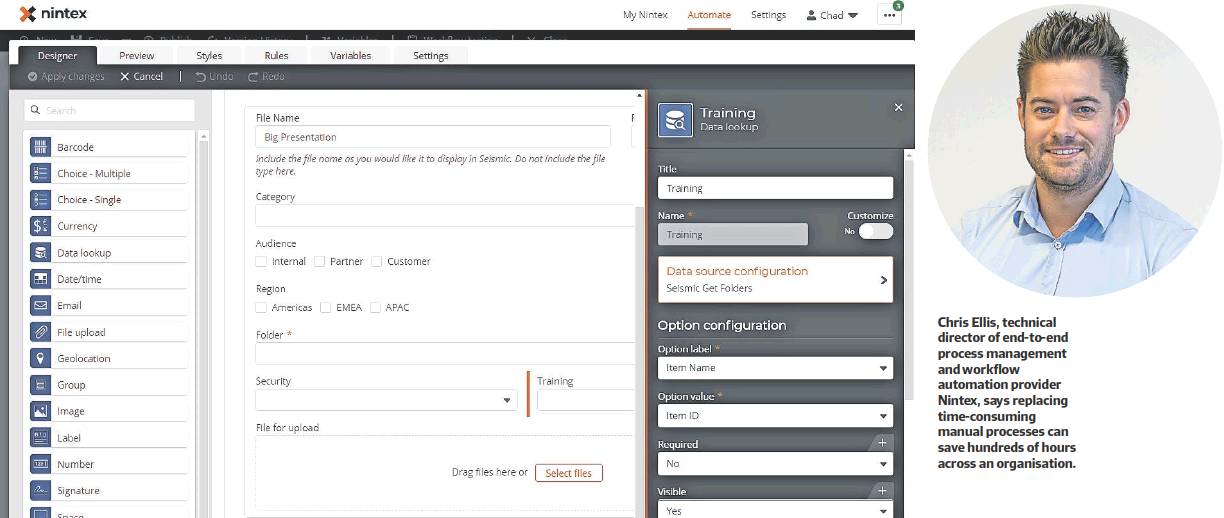Declaring war on paperwork, processes
Beyond the efficiency benefits of digitising and automating workflows, the COVID-19 pandemic is also seeing businesses strive to reduce paperwork in order to enforce social distancing efforts and limit the spread of the virus throughout the organisation.
For all the effort businesses are investing in COVID-safe workplaces, a simple paper form has the potential to pass infections between coworkers and across departments. A wayward piece of paper could also see the virus jump between shifts or separated A/B teams as part of the handover process, thwarting business continuity efforts and potentially bringing operations to a standstill.
While there are clearly COVID-safe benefits in digitising customer-facing processes such as application forms, the pandemic has seen growing demand from back office administrative departments for paperless processes such as HR, accounting and compliance.
Meanwhile, manufacturing is also looking to digitise traditional paper-heavy workflows that cross internal boundaries, from timesheets and rosters to processes which involve walking along the different segments of a production line and checking off items on a clipboard.
As with many digital transformation projects, COVID-19 has accelerated business process automation efforts and is creating an opportunity for businesses to re-evaluate long-held work practices.
Digitising and automating business processes also helps organisations address the mobility challenges which COVID-19 has brought to the fore, such as document generation and electronic signatures along with catering to BYOD, addressing security concerns and meeting mobile device management challenges.
Away from the front line, business process mapping and management tools are also offering managers and senior leadership insight into the impact of manual processes and paperwork on the efficiency and effectiveness of their workforce.
The benefits of business process mapping include standardisation and improved accuracy along with enhancing systems of record, accountability, compliance and risk management. Rather than simply lift and shift existing workflows by digitising and automating manual processes, business process mapping also allows organisations to identify opportunities for improvement by tracking the time and effort involved in processes.
Often the business leader who owns a process has a focus higher up the chain and is not as familiar with the day-to-day execution of a procedure. They can be removed from the daily challenges, implementation hurdles and potential impact on the business at a granular level, says Chris Ellis, technical director of end-to-end process management and workflow automation provider Nintex.
Nintex Workflow Cloud allows organisations to automate work and processes with easy-to-use software that relies on clicks rather than coding, and lets organisations eliminate broken and highly manual processes to achieve rapid digital transformation.
This ease of use is driving the democratisation of business process mapping tools, Ellis says, with Nintex Workflow Cloud’s object support creating more integrations for workflows with different APIs and systems of record including Microsoft 365, Google, Salesforce and others.
A growing awareness of the impact of business process automation on business outcomes means that today most of Nintex’s conversations are with its customers’ business unit leads, department heads and senior leadership rather than with developers and SharePoint administrators.
Features such as Nintex Promapp’s cycle cost, expose the true active and wait time when executing a process as-is, making it easy to justify an automation effort and determine the subsequent return on investment post automation. This makes it easier to ensure that efforts are driven by the business rather than IT, aligning with the business needs and delivering value.
‘‘A front-line worker might only save a few minutes by automating a process, but when the business leader who owns the process looks at it across the organisation you could be talking about hundreds of hours each month or year,’’ Ellis says.
Centralised business process mapping and management tools, with business intelligence and auditing capabilities, also allow organisations to create an internal centre of excellence to ensure that departments and business units aren’t reinventing the wheel to solve common challenges.
Nintex also offers an online process accelerator gallery, featuring hundreds of free downloadable templates to jump-start automation in many areas like customer service, sales and marketing, finance, legal, HR, IT, procurement and operations. Templates include process maps, workflows, botflows, connectors and tools.
‘‘It’s not just about saving time and effort,’’ Ellis says. ‘‘Once you’re using business process management to truly understand what your people do each day then you can identify all those little opportunities to implement best practice and do things better.
‘‘Nintex Workflow Cloud caters well to standard verticals such as HR and accounts payable, which deal with structured data and structured workflows, but during the pandemic we’ve seen more customers take advantage of the platform’s power and flexibility to really declare war on physical paperwork and manual processes while unlocking business benefits.’’
